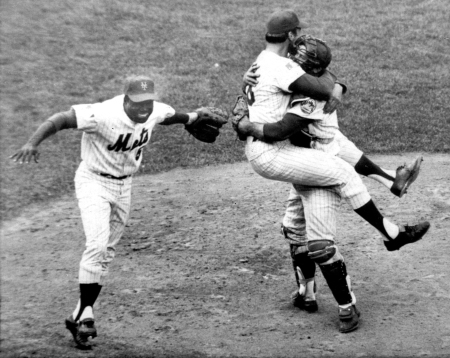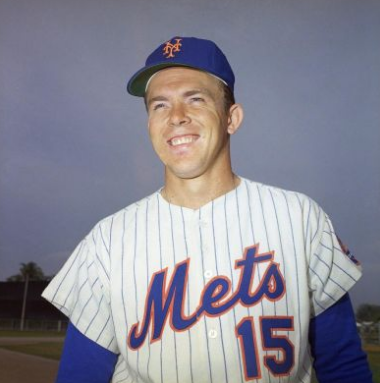 Winning was Jerry Grote’s bliss. In fact, his most joyous moment on the diamond was captured on film when teammate Jerry Koosman leapt into his arms after the final out of the 1969 World Series.
Winning was Jerry Grote’s bliss. In fact, his most joyous moment on the diamond was captured on film when teammate Jerry Koosman leapt into his arms after the final out of the 1969 World Series.
In 1976, Bob Myrick found out the hard way how Grote felt about losing when the Mets rookie pitcher beat his catcher in a game of Backgammon, causing Grote to explode, sending the board and its pieces across the room with a single swing of the arm.
“I just sat there staring at him – hard,” remembered Myrick. “He got up and picked up all the pieces, and we never had a cross word. He was a perfectionist.”
Grote’s desire to win led to unparalleled intensity on the field. During his 12-year career in New York, teammates labeled Grote surly, irascible, testy and moody. Then, there’s Koosman’s description: “If you looked up red-ass the dictionary, his picture would be in there. Jerry was the guy you wanted on your side, because he’d fight you tooth and nail ‘til death to win a ball game.”
Grote played with an anger and intensity that was, at times, intimidating to opponents, umpires, the media and teammates alike.
“When I came up I was scared to death of him,” said Jon Matlack, winner of the 1972 Rookie of the Year award. “If you bounced a curveball in the dirt, he’d get mad. I worried about him more than the hitter.”
“He could be trouble if you didn’t do what he said,” added former Met Craig Swan. “He wanted you to throw the pitches he called. He made it very simple. I would shake him off now and then, and he would shake his head back at me. If a guy hit a home run off of me, he wouldn’t let me hear the end of it.”
Grote had a special way of letting his pitchers know he wasn’t pleased with a pitch. “Jerry had such a great arm. He could throw with great control and handcuff you in front of your belt buckle,” remembers Koosman.
Grote would get incensed when Jim McAndrew was on the mound. “McAndrew would never challenge hitters according to where Grote wanted the ball; so Grote kept firing it back and handcuffing him in front of the belt buckle, and we would laugh, because we knew what Grote was doing,” said Koosman.
 The tactic didn’t go over so well when Koosman pitched. During a game when Koosman was struggling to find his control, Grote began firing the ball at his pitcher’s belt buckle. Koosman called Grote to the mound.
The tactic didn’t go over so well when Koosman pitched. During a game when Koosman was struggling to find his control, Grote began firing the ball at his pitcher’s belt buckle. Koosman called Grote to the mound.
“I told him, ‘If you throw the ball back at me like that one more time I am going to break your f—ing neck,’” Koosman told Peter Golenbeck in Amazin’. “I turned around and walked back to the mound, and he never threw it back at me again. We had great respect for each other after that.”
He took his frustration out on umpires too. Retired umpire Bruce Froemming claims Grote intentionally let a fastball get by him, nearly striking Froemming in the throat. Because they had spent the three previous innings in a non-stop argument, Froemming accused Grote of intentionally moving aside in hope that the pitch would hit the umpire.
“Are you going to throw me out?” snapped Grote.
“He made no attempt to stop that pitch,” Froemming thought. The home plate umpire fumed but realized he had no grounds to toss Grote from the game.
National League umpires were well aware of Grote, and his on-field demeanor. In fact, in 1975, the league was discussing physical contact between catchers and umpires. Jerry Crawford was queried about his unique style of resting a hand between a catcher’s hip and rib cage and he said, “I ask the catcher if it bothers him, and only Jerry Grote has complained.”
“The writers never respected Grote, but they guys who played with him could barely stand him,” said Ron Swoboda. “He was a red-ass Texan who loved to f— with people but who didn’t like anyone to f— with him. It was a one-way street. Grote is Grote, and we would not have been as good without him behind home plate.”
“Grote had a red-ass with the media, but he didn’t care,” added Koosman. “All he cared about was what he did on the field. If you didn’t get your story from what he did out there, you either talked to him nicely or he wasn’t going to give you any more story.”
Grote did not return calls or respond to multiple email requests for an interview for this story.
This is who Jerry Grote is – and the Mets knew it from the day they traded for him for a player to be named later in October 1965.
“When we got him, I don’t think anyone else had that big of an opinion of him,” said Bing Devine. “Jerry was withdrawn and had a negative personality, but he knew how to catch a ball game and how to handle pitchers, and maybe that very thing helped him to deal with the pitching staff. He was great. I know he surpassed our expectations.”
He was exactly what the Mets needed to manage a young, extremely talented pitching staff, but he was clearly a handful to manage too.
“If he ever learns to control himself, he might become the best catcher in baseball,” former Mets manager Wes Westrum told the media during Grote’s first season in New York.
Then, in 1968, Gil Hodges arrived. After being briefed on the Mets roster, Hodges said he “did not like some of the things I heard about Jerry. He had a habit of getting into too many arguments with umpires and getting on some of the older players on the club.”
Hodges, known for his firm, but fair, demeanor, took Grote into his office for an attitude adjustment. The Mets manager realized the importance of Grote’s talents and how it would affect the pitching staff. Hodges made his expectations clear.
“I hesitate to imagine where the New York Mets would have been the last few years without Jerry,” Hodges told Sports illustrated in 1971. “He is invaluable to us. He is intent and intense and he fights to get everything he can.”
Grote batted .256 in his 12 seasons in New York. He is a two-time All-Star (1968 and 1974). In 1969, Grote threw out 56% of baserunners. He ranks third on the Mets all-time list for games played (1235), 11th in hits (994), 15th in doubles and total bases (1413).
Grote fractured his wrist after getting hit by a pitch in May 1973. The Mets recorded three shutouts the first month with Grote behind the plate, four more shutouts over the next two months (May 12-August 11) without Grote behind the plate and eight more shutouts over the final six weeks of the season with Grote managing the staff. Grote caught every inning of every playoff and World Series game in 1969 and 1973. Here’s a statistic for you: In the 20 post season games between ’69 and ’73, the Mets used 45 pitchers and one catcher. Those were the only two post season appearances the Mets made during Grote’s 12 years in New York.
“One of the advantages of playing for New York is that the big crowds at Shea Stadium help you tremendously,” Grote said in a 1971 interview with Sports Illustrated. “They make you want to give 115% all the time. In other places it cannot be the same for the players. Like in Houston, nobody seems to applaud unless the hands on the scoreboard start to clap. Once those hands stop, so do all the others. Real enthusiasm.”
Grote loved playing in New York, and New York loved his gritty style.














